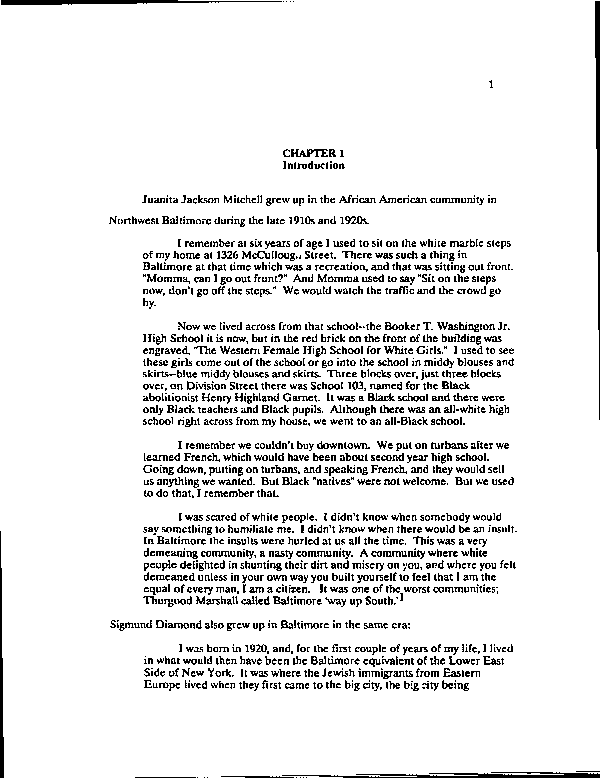|
CHAPTER 1
Introduction
Juanita Jackson Mitchell grew up in the African American community in
Northwest Baltimore during the late 1910s and 1920s.
I remember at six years of age I used to sit on the white marble steps
of my home at 1326 McCuIloug** Street. There was such a thing in
Baltimore at that time which was a recreation, and that was sitting out front.
"Momma, can I go out front?" And Momma used to say "Sit on the steps
now, don't go off the steps." We would watch the traffic and the crowd go
by.
Now we lived across from that school-the Booker T. Washington Jr.
High School it is now, but in the red brick on the front of the building was
engraved, "The Western Female High School for White Girls." I used to see
these girls come out of the school or go into the school in middy blouses and
skirtsóblue middy blouses and skirts. Three blocks over, just three blocks
over, on Division Street there was School 103, named for the Black
abolitionist Henry Highland Garnet. It was a Black school and there were
only Black teachers and Black pupils. Although there was an all-white high
school right across from my house, we went to an all-Black school.
I remember we couldn't buy downtown. We put on turbans after we
learned French, which would have been about second year high school.
Going down, putting on turbans, and speaking French, and they would sell
us anything we wanted. But Black "natives" were not welcome. But we used
to do that, I remember that
I was scared of white people. I didn't know when somebody would
say something to humiliate me. I didn't know when there would be an insult.
In Baltimore the insults were hurled at us all the time. This was a very
demeaning community, a nasty community. A community where white
people delighted in shunting their dirt and misery on you, and where you felt
demeaned unless in your own way you built yourself to feel that I am the
equal of every man, I am a citizen. It was one of the worst communities;
Thurgood Marshall called Baltimore *way up South.'1
Sigmund Diamond also grew up in Baltimore in the same era:
I was born in 1920, and, for the first couple of years of my life, I lived
in what would then have been the Baltimore equivalent of the Lower East
Side of New York. It was where the Jewish immigrants from Eastern
Europe lived when they first came to the big city, the big city being
|

